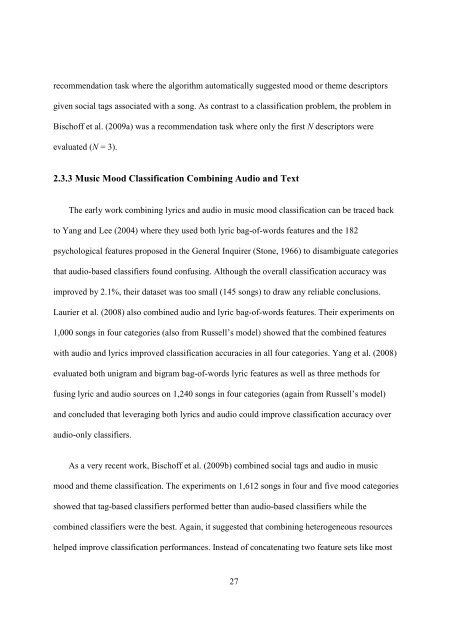improving music mood classification using lyrics, audio and social tags
improving music mood classification using lyrics, audio and social tags
improving music mood classification using lyrics, audio and social tags
Create successful ePaper yourself
Turn your PDF publications into a flip-book with our unique Google optimized e-Paper software.
ecommendation task where the algorithm automatically suggested <strong>mood</strong> or theme descriptors<br />
given <strong>social</strong> <strong>tags</strong> associated with a song. As contrast to a <strong>classification</strong> problem, the problem in<br />
Bischoff et al. (2009a) was a recommendation task where only the first N descriptors were<br />
evaluated (N = 3).<br />
2.3.3 Music Mood Classification Combining Audio <strong>and</strong> Text<br />
The early work combining <strong>lyrics</strong> <strong>and</strong> <strong>audio</strong> in <strong>music</strong> <strong>mood</strong> <strong>classification</strong> can be traced back<br />
to Yang <strong>and</strong> Lee (2004) where they used both lyric bag-of-words features <strong>and</strong> the 182<br />
psychological features proposed in the General Inquirer (Stone, 1966) to disambiguate categories<br />
that <strong>audio</strong>-based classifiers found conf<strong>using</strong>. Although the overall <strong>classification</strong> accuracy was<br />
improved by 2.1%, their dataset was too small (145 songs) to draw any reliable conclusions.<br />
Laurier et al. (2008) also combined <strong>audio</strong> <strong>and</strong> lyric bag-of-words features. Their experiments on<br />
1,000 songs in four categories (also from Russell’s model) showed that the combined features<br />
with <strong>audio</strong> <strong>and</strong> <strong>lyrics</strong> improved <strong>classification</strong> accuracies in all four categories. Yang et al. (2008)<br />
evaluated both unigram <strong>and</strong> bigram bag-of-words lyric features as well as three methods for<br />
f<strong>using</strong> lyric <strong>and</strong> <strong>audio</strong> sources on 1,240 songs in four categories (again from Russell’s model)<br />
<strong>and</strong> concluded that leveraging both <strong>lyrics</strong> <strong>and</strong> <strong>audio</strong> could improve <strong>classification</strong> accuracy over<br />
<strong>audio</strong>-only classifiers.<br />
As a very recent work, Bischoff et al. (2009b) combined <strong>social</strong> <strong>tags</strong> <strong>and</strong> <strong>audio</strong> in <strong>music</strong><br />
<strong>mood</strong> <strong>and</strong> theme <strong>classification</strong>. The experiments on 1,612 songs in four <strong>and</strong> five <strong>mood</strong> categories<br />
showed that tag-based classifiers performed better than <strong>audio</strong>-based classifiers while the<br />
combined classifiers were the best. Again, it suggested that combining heterogeneous resources<br />
helped improve <strong>classification</strong> performances. Instead of concatenating two feature sets like most<br />
27
















